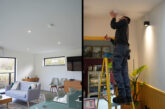
The experts at Aico explore the benefits of accessible alarm controls and discuss how their use can enhance fire safety.
Smoke and Carbon Monoxide (CO) alarms play a crucial role in early fire detection, however, accessibility to these alarms can pose a challenge for individuals with physical limitations or when alarms are installed in hard-to-reach areas.
Low-level smoke and CO alarm controls, such as Aico’s Ei450 RadioLINK Alarm Controller, provide an efficient solution to these challenges.
Accessible control over alarms
Low-level control switches provide occupants with accessible control over their alarm systems, enabling them to test, locate, and silence alarms from a convenient location. This feature is particularly beneficial for individuals who may struggle to reach high-mounted alarms or those with limited mobility.
Low-level switches offer a simple method to identify the sounding alarm in the event of activation, which is especially crucial in homes equipped with a combination of smoke and CO alarms.
While regular alarm testing is essential for ensuring proper functionality, recent data reveals a concerning trend.
A study of over 50,000 homes (predominantly social housing), connected using HomeLINK technology, indicated that only half of the properties had alarms linked to low-level control switches.
This disparity in accessibility resulted in a striking difference in alarm testing behaviour. Over 60% of homes with low-level control switches tested their alarms at least once within the past year, with this number decreasing dramatically to 24% in homes without these switches.
This data highlights a critical issue: the lack of engagement with fire safety measures among occupants of homes without low-level control switches. The 76% non-testing rate suggests that homeowners may not be adequately aware of the potential dangers posed by fire hazards and may not be taking necessary precautions to protect themselves and their loved ones.
The over 60% testing rate in homes with low-level control switches demonstrates the positive impact of accessible alarm testing.
By facilitating regular testing, these switches educate the occupier to recognise the different sound patterns that fire and CO alarms make. This encourages occupants to think about fire safety and prompts them to consider potential fire hazards, develop escape plans, and discuss fire safety measures with family members.
Higher levels of protection
Statistics published by the Home Office reveal that the majority of fatal domestic fires occur in properties with either no or non-functioning smoke alarms.
While occupants in homes with working alarms are undoubtedly safer, the data suggests that those who actively test their alarms will have an even higher level of protection.
Regular testing indicates a heightened awareness of fire risks and a willingness to take additional steps for home life safety.
Removing barriers to enable participation and engagement is a common theme in various aspects of life, so low-level smoke and CO alarm control switches represent a successful example of barrier removal in the realm of domestic fire safety. The data overwhelmingly supports the positive impact of these switches on alarm testing.
Visit the Aico Ei450 RadioLINK Alarm Controller product information page here
Read more of the latest industry feature articles here









